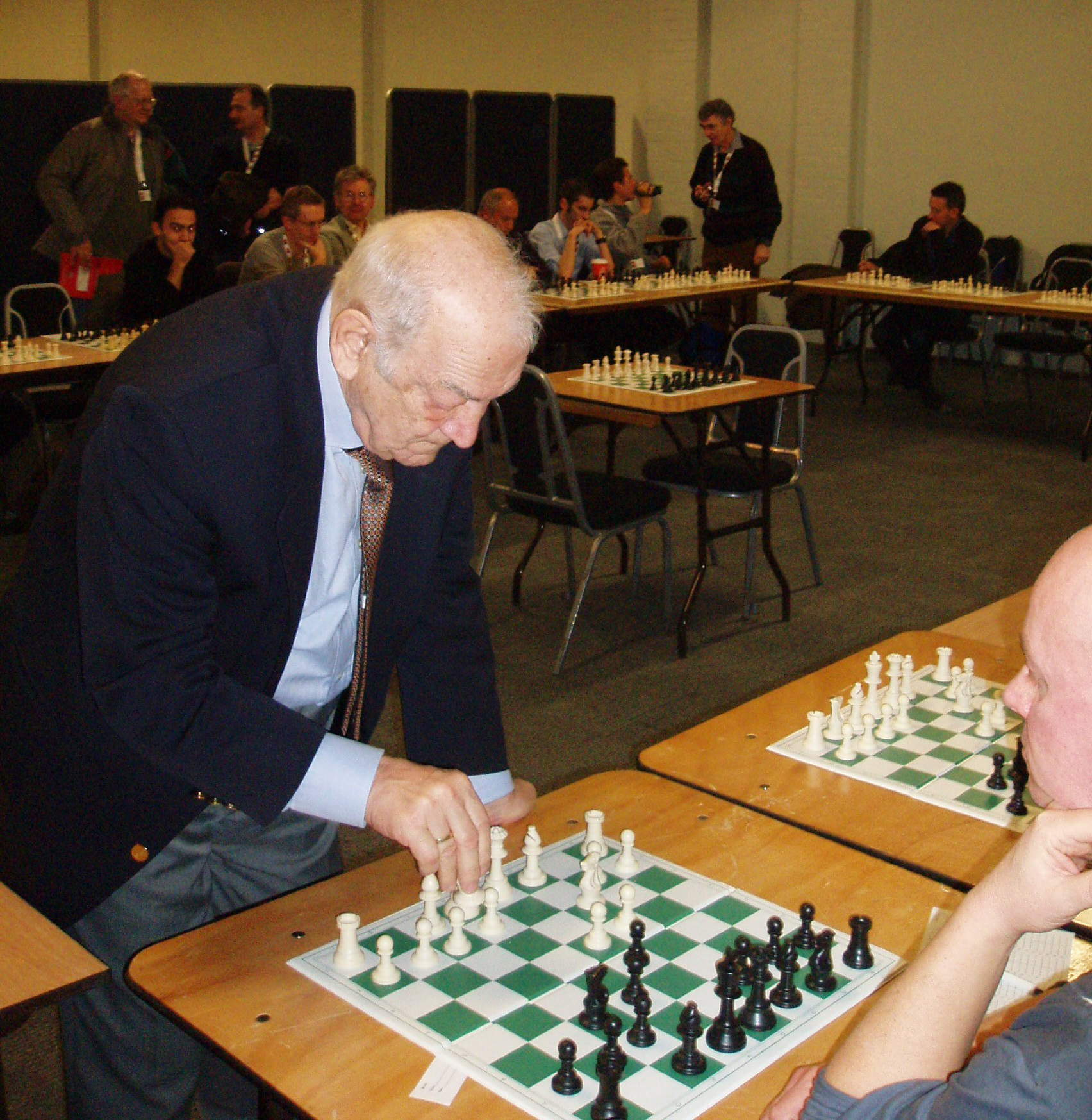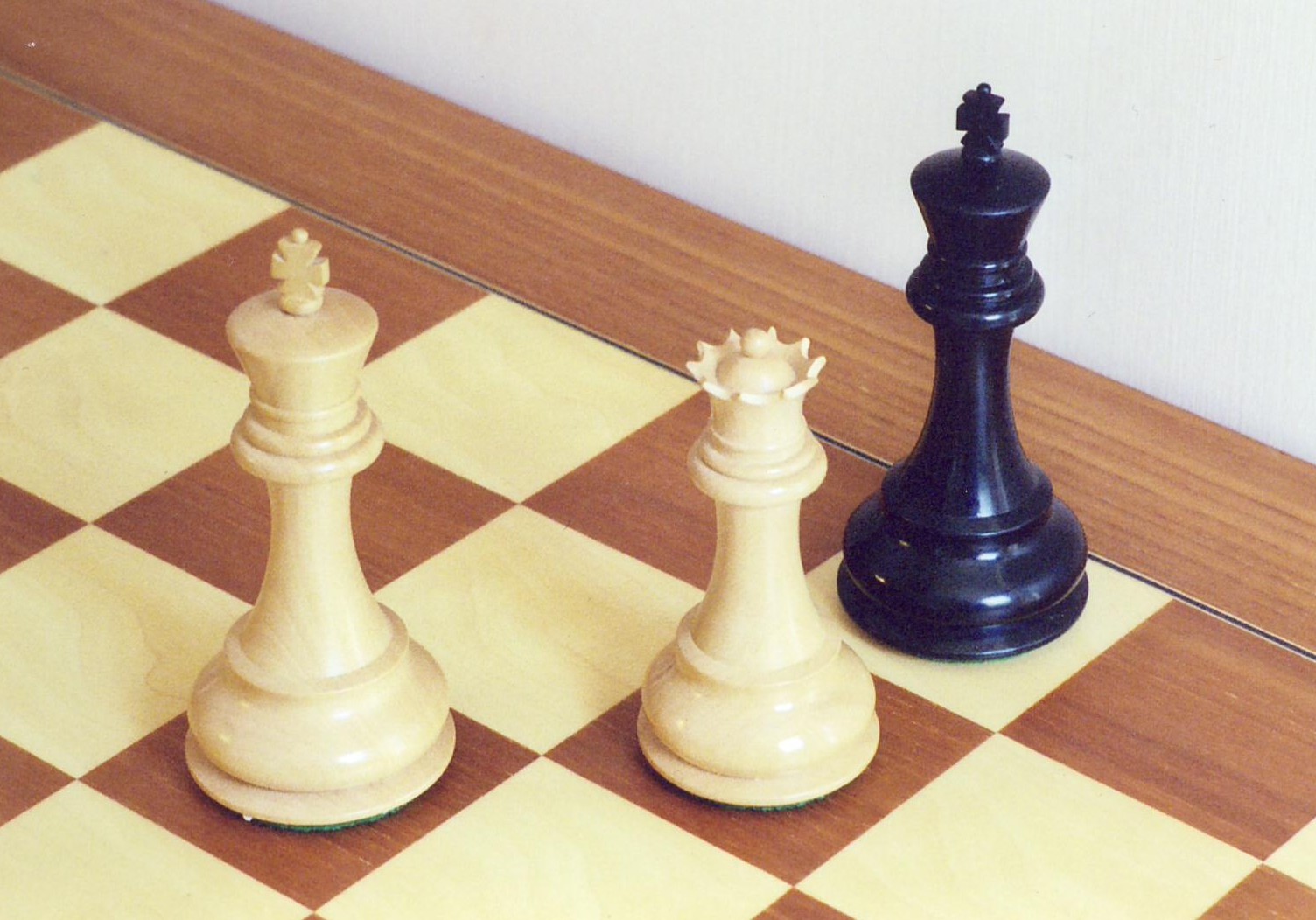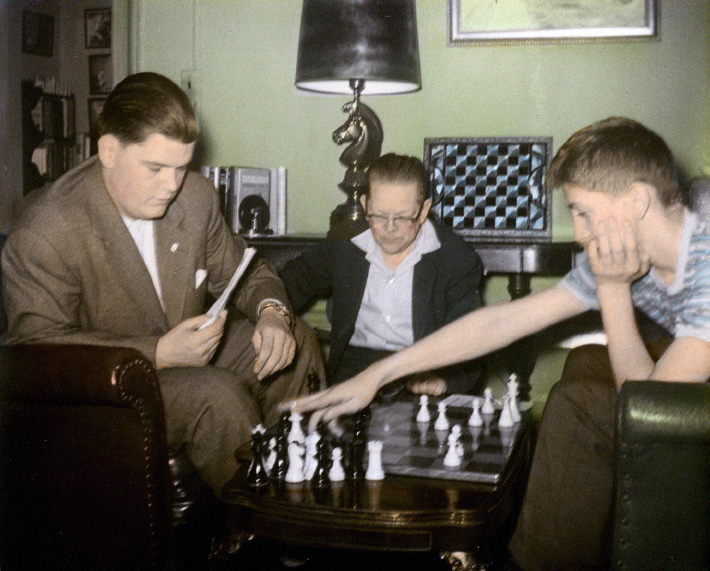|
Simultaneous Chess
A simultaneous exhibition or simultaneous display is a board game exhibition (commonly chess or Go) in which one player (typically of high rank, such as a grandmaster or dan-level player) plays multiple games at a time with a number of other players. Such an exhibition is often referred to simply as a "simul". Procedure In a regular simul, no chess clocks are used (if they are involved it is called a ''clock simul''). The boards are usually arranged in a large circle or square and the exhibitor walks from board to board in a fixed order. Each individual participant is expected to make a move when the exhibitor arrives at their board. The exhibitor may pause briefly before playing their move, but will typically attempt to avoid lengthy pauses because too many such pauses will cause the exhibition to continue for an extended period. Longer exhibitions increase the risk of fatigue-induced blunders on the part of the exhibitor, especially since the individual participants remaini ... [...More Info...] [...Related Items...] OR: [Wikipedia] [Google] [Baidu] |
Vlastimil Hort
Vlastimil Hort (born 12 January 1944) is a German chess Grandmaster. During the 1960s and 1970s he was one of the world's strongest players and reached the 1977–78 Candidates Tournament for the World Chess Championship, but never qualified for a competition for the actual title. Hort was born in Kladno, Czechoslovakia and was a citizen of Czechoslovakia for the first part of his chess career. He achieved the Grandmaster title in 1965. He won a number of major international tournaments (Hastings 1967–68, Skopje 1969, etc.) and national championships (1970, 1971, 1972, 1975, and 1977). He gained recognition as one of the strongest non-Soviet players in the world, which led to him representing the "World" team in the great "USSR vs. Rest of the World" match of 1970, where he occupied fourth board and had an undefeated +1 score against the Soviet Grandmaster Lev Polugaevsky—in some respects his greatest result. He defected to the West in 1985, moving to West Germany and winn ... [...More Info...] [...Related Items...] OR: [Wikipedia] [Google] [Baidu] |
Glossary Of Chess
This glossary of chess explains commonly used terms in chess, in alphabetical order. Some of these terms have their own pages, like ''#fork, fork'' and ''#pin, pin''. For a list of unorthodox chess pieces, see Fairy chess piece; for a list of terms specific to chess problems, see Glossary of chess problems; for a list of named #opening, opening lines, see List of chess openings; for a list of chess-related games, see List of chess variants. A B , "lightning"] A #fast chess, fast form of chess with a very short #time control, time limit, usually three or five minutes per player for the entire game. With the advent of electronic #chess clock, chess clocks, the time remaining is often incremented by one or two seconds per move.Schiller 2003, p. 398 C ... [...More Info...] [...Related Items...] OR: [Wikipedia] [Google] [Baidu] |
Edward Winter (chess Historian)
Edward Winter (born 1955) is an English chess journalist, archivist, historian, collector and author. He writes a regular column on chess history, ''Chess Notes.'' ''Chess Notes'' ''Chess Notes'' started as a bimonthly periodical, and was described by its author, in the first issue (January–February 1982), as "A forum for aficionados to discuss all matters relating to the Royal Pastime". At the end of 1989, the periodical ceased publication. In 1993, Winter resumed publication of ''Chess Notes'', which appeared, this time, as a syndicated column, in many languages around the world. From 1998 to 2001, it was published exclusively in '' New In Chess''. Later, it appeared online at the Chess Café website. Since September 2004, ''Chess Notes'' has been located at the website Chesshistory.com. Between 1996 and 2006 four anthologies of ''Chess Notes'' were published in book form. On 15 March 2020, in C.N. 11763, Edward Winter announced that from the end of March 2020, ''Chess Notes' ... [...More Info...] [...Related Items...] OR: [Wikipedia] [Google] [Baidu] |
Tandem Simultaneous Exhibition
A tandem simultaneous exhibition or leapfrog simultaneous exhibition or partnership chess is a form of simultaneous exhibition in which more than one players (typically of high rank, such as a grandmaster or dan-level player) play multiple games at a time with a number of other players, making successive moves without consulting one another. Such an exhibition is often referred to simply as a "tandem simul" or "leapfrog simul". When conducted by more than two experts, it is often called a sequential simul. History The earliest recorded tandem chess happened in 1892. The following passage below appeared on page 8 of the Chess Review, September 1892: London. A novel exhibition of simultaneous play took place recently at the private house of a chess enthusiast in the West End of London. On the occasion in question, Mr Lee and a first-class London amateur played simultaneously in partnership against eight opponents, three of whom were ladies. The two simultaneous performers wal ... [...More Info...] [...Related Items...] OR: [Wikipedia] [Google] [Baidu] |
Marc Esserman
Marc Esserman (born July 28, 1983) is an American chess player who currently holds the FIDE title of International Master (IM). Scholastic career Esserman began playing chess at the age of 7. Scholastic competition resulted in two national team titles in 1994 and 1995. In April 1997, at the first-ever Super Nationals in Knoxville, Tennessee, he went undefeated (7–0) to become the K-8 co-champion, edging out several players rated over 400 points higher. In March 1999, Esserman tied for 1st in the Florida State Championship, again with a perfect score. Press coverage of Esserman's chess career continued while an undergraduate at Harvard College. There, he was active promoting chess on campus, serving as captain of the Harvard Chess Club for four years, and helping to organize a chess exchange trip to Beijing, China. There, he played (and defeated) the women's world champion, Xu Yuhua, as part of an inter-university match. During high school and college, Esserman trained under ... [...More Info...] [...Related Items...] OR: [Wikipedia] [Google] [Baidu] |
Lichess
Lichess (; ) is a free and open-source Internet chess server run by a non-profit organization of the same name. Users of the site can play online chess anonymously and optionally register an account to play rated games. Lichess is ad-free and all the features are available for free, as the site is funded by donations from patrons. Features include chess puzzles, computer analysis, tournaments and chess variants; not all features are available to anonymous players, such as reviewing specific games. History Lichess was founded in 2010 by French programmer Thibault Duplessis. The software running Lichess and the design are mostly open source under the AGPL license and other free and non-free licenses. On February 11, 2015, an official Lichess mobile app was released for Android devices. An app for mobile devices running iOS was released on March 4, 2015. As of April 28, 2022, lichess.org had a global rank of 683 at Alexa, with most of its visitors coming from the United Stat ... [...More Info...] [...Related Items...] OR: [Wikipedia] [Google] [Baidu] |
Checkmate
Checkmate (often shortened to mate) is any game position in chess and other chess-like games in which a player's king is in check (threatened with ) and there is no possible escape. Checkmating the opponent wins the game. In chess, the king is never actually captured—the player loses as soon as the player's king is checkmated. In formal games, it is usually considered good etiquette to resign an inevitably lost game before being checkmated. If a player is not in check but has no legal move, then it is '' stalemate'', and the game immediately ends in a draw. A checkmating move is recorded in algebraic notation using the hash symbol "#", for example: 34.Qg3#. Examples A checkmate may occur in as few as two moves on one side with all of the pieces still on the board (as in Fool's mate, in the opening phase of the game), in a middlegame position (as in the 1956 game called the Game of the Century between Donald Byrne and Bobby Fischer), or after many moves with as few as t ... [...More Info...] [...Related Items...] OR: [Wikipedia] [Google] [Baidu] |
Svetozar Gligorić
Svetozar Gligorić (Serbian Cyrillic: Светозар Глигорић, 2 February 1923 – 14 August 2012) was a Serbian and Yugoslav chess grandmaster and musician. He won the championship of Yugoslavia a record twelve times, and is considered the best player ever from Serbia. In 1958, he was declared the best athlete of Yugoslavia. In the 1950s and 1960s, Gligorić was one of the top players in the world. He was also among the world's most popular players, owing to his globe-trotting tournament schedule and a particularly engaging personality, reflected in the title of his autobiography, ''I Play Against Pieces'' (i.e., without hostility toward the opponent, and not differently against different players for "psychological" reasons; playing "the board and not the man"). Life Gligorić was born in Belgrade to a poor family. According to his recollections, his first exposure to chess was as a small child watching patrons play in a neighborhood bar. He began to play at the a ... [...More Info...] [...Related Items...] OR: [Wikipedia] [Google] [Baidu] |
Modern Chess Openings
''Modern Chess Openings'' (usually called ) is a reference book on chess openings, first published in 1911 by the British players Richard Clewin Griffith (1872–1955) and John Herbert White (1880–1920). The fifteenth edition was published in 2008. Harry Golombek called it "the first scientific study of the openings in the twentieth century".Harry Golombek (editor-in-chief), ''Golombek's Encyclopedia of Chess'', Crown Publishers, 1977, p. 202. . History Although Bilguer's ''Handbuch des Schachspiels'' was more authoritative at the time ''MCO'' was first published, it was last published between 1912 and 1916, and was becoming outdated by the 1930s. ''MCO'' was popular with English-speaking players and has continued to be updated throughout the 20th century and into the 21st, with fifteen editions from 1911 through 2008. Early editions were small enough to fit in a pocket (the first edition was 190 pages), but later editions grew and the fifteenth and most recent version is 768 ... [...More Info...] [...Related Items...] OR: [Wikipedia] [Google] [Baidu] |
Elephant Gambit
The Elephant Gambit (also called the Queen's Pawn Countergambit or Englund Counterattack) is a rarely played chess opening beginning with the moves: :1. e4 e5 :2. Nf3 d5 Although the Elephant Gambit is considered unsound, it has been used frequently by the Barbadian master Philip Corbin. Lines White is able to capture either of Black's center pawns with the advantage, either by 3.exd5 or 3.Nxe5. With a center pawn removed, Black is in a passive position with White clearly having the initiative as White controls more . 3.exd5 Black's responses to 3.exd5 include 3...e4 and 3...Bd6 (the Elephant Gambit proper). 3...Qxd5 saves the pawn, but leaves White with a big lead in after 4.Nc3. 3...e4 After 3...e4 4.Qe2 Nf6 lines might continue: * 5.d3 Qxd5 6.Nbd2 Be7 7.dxe4 Qe6 and White remains a pawn ahead, although Black's development is somewhat smoother. * 5.d3 Be7 6.dxe4 0-0 7.Nc3 Re8 8.Bd2 Bb4 9.0-0-0, with advantage for White (Nick de Firmian). * 5.Nc3 Be7 6.Nxe4: ** 6...Nxd ... [...More Info...] [...Related Items...] OR: [Wikipedia] [Google] [Baidu] |
My 60 Memorable Games
''My 60 Memorable Games'' is a chess book by Bobby Fischer, first published in 1969. It is a collection of his games dating from the 1957 New Jersey Open to the 1967 Sousse Interzonal. Unlike many players' anthologies, which are often titled ''My Best Games'' and include only wins or draws, ''My 60 Memorable Games'' includes nine draws and three losses. It has been described as a "classic of objective and painstaking analysis" and is regarded as one of the great pieces of chess literature. The book was originally published in descriptive notation. An algebraic notation version in 1995 caused some controversy in the chess world because of the many other changes made to the text, with Fischer himself denouncing the edition. In 2008 a reissue of Fischer's original text was published, the only changes being the updating to algebraic notation and the correcting of typographical errors, notation mistakes, and the erroneous last few moves of game 17. Writing The book had been planned f ... [...More Info...] [...Related Items...] OR: [Wikipedia] [Google] [Baidu] |
Bobby Fischer
Robert James Fischer (March 9, 1943January 17, 2008) was an American chess grandmaster and the eleventh World Chess Champion. A chess prodigy, he won his first of a record eight US Championships at the age of 14. In 1964, he won with an 11–0 score, the only perfect score in the history of the tournament. Qualifying for the 1972 World Championship, Fischer swept matches with Mark Taimanov and Bent Larsen by 6–0 scores. After another qualifying match against Tigran Petrosian, Fischer won the title match against Boris Spassky of the USSR, in Reykjavík, Iceland. Publicized as a Cold War confrontation between the US and USSR, the match attracted more worldwide interest than any chess championship before or since. In 1975, Fischer refused to defend his title when an agreement could not be reached with FIDE, chess's international governing body, over the match conditions. Consequently, the Soviet challenger Anatoly Karpov was named World Champion by default. Fischer subseq ... [...More Info...] [...Related Items...] OR: [Wikipedia] [Google] [Baidu] |

.jpg)



